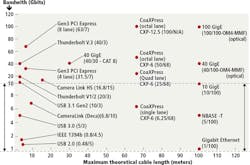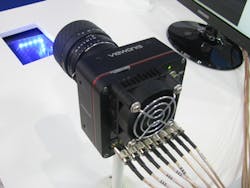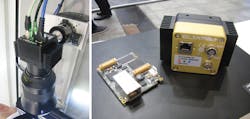Developers of machine vision systems face a plethora of cameras and camera interface standards.
Numerous cameras are now available that are tailored specifically for industrial machine vision, medical and scientific applications. With these choices, many cameras are offered with a range of interfaces ranging from bus-based designs such as USB and FireWire, to networked-based systems based on Gigabit Ethernet or point-to-point, more deterministic interfaces such as Camera Link, Camera Link HS and CoaXPress (CXP).
After considering which camera and camera interface is the best possible solution for a given application, systems designers are also faced with numerous types of cables and connectors that will best fit their application. To fully comprehend the numerous options that are available, all these considerations must be taken into account.
Camera interfaces
As digital camera interfaces have replaced their analog counterparts, numerous standards have been proposed and adopted. These include computer-interface peripheral standards such as Firewire (1394), USB, PCIExpress and Thunderbolt, computer networking standards such as Gigabit Ethernet, 10 Gigabit Ethernet and NBASE-T and those such as Camera Link, Camera Link HS and CoaXPress that have been especially developed for the machine vision industry.
While each standard presents its own price/performance tradeoffs, the need to tailor many of these to meet the needs of machine vision systems has led the AIA (Ann Arbor, MI USA; www.visiononline.org) to standardize GigE Vision, Camera Link, Camera Link HS, Camera Link HS and USB3 Vision, while the Japan Industrial Imaging Association's Technical Committee (JIIA, Tokyo, Japan; http://jiia.org) is responsible for the maintenance of the CXP standard.
One of the main factors when choosing such an interface is the bandwidth and the camera-to-cable distances that can be achieved. However, comparing the different standards available can be confusing.
In an amended graph originally supplied by FLIR Integrated Imaging Solutions Inc. (formerly Point Grey; Richmond, BC, Canada; www.ptgrey.com), Vision Systems Design has attempted to compare many of the most current and future camera interface standards (Figure 1). While the chart plots the bandwidth in Gigabits/s against the maximum cable length available, the maximum cable charted is for copper cable. Thus, for example, while the maximum Camera Link (Deca) standard is shown as 6.8Gbits/s, the 10m (maximum) cable length is shown. However, as with the many other standards shown, embedded repeaters and optical extenders can be used to extend this distance to hundreds and often thousands of meters (see "Extending the reach of machine vision interfaces," Vision Systems Design, September 2014; bit.ly/VSD-14-EXT).
While established standards such as USB 3, Camera Link, CXP and GigE Vision are supported by numerous camera vendors, other less well-endorsed interfaces were demonstrated at VISION 2016 in Stuttgart last year. One of these camera computer connections-the PCI Express (PCIe) interface - was shown by Ximea (Münster, Germany; www.ximea.com) transferring data from a range of cameras directly to PC memory.
The concept of using the host PC's interface to transfer data from camera to computer is not new, however. Nine years ago, Point Grey demonstrated a camera that used the PCI Express 1.1 (PCIe) interface to transfer image data directly to a host PC without requiring a traditional frame grabber. The prototype camera used an EEX1 PCIe host adapter card from Magma (San Diego, CA, USA; www.magma.com) to transfer 1920 × 1080-pixel 24-bit RGB images at 22fps across a 3m PCI Express-approved cable from Molex (Lisle, IL, USA; www.molex.com) to the host PC (see "Compensated cable extends PCI Express," Vision Systems Design, August 2008, http://bit.ly/VSD-08-CAB).
In the demonstration shown at VISION 2016, Max Larin, CEO of Ximea showed how his company had developed a PCIe-based camera system capable of supporting a number of different cameras and resolutions (Figure 2a and Figure 2b). At the heart of the system, a PCIe switch from PLX Technology - now part of Avago Technologies (San Jose, CA, USA; www.avagotech.com) - is used to interface to two Gen 2 or Gen 3 (x4), two Gen 2 or Gen 3 (x8), one Gen 3 (x8) connectors and to two USB3 Gen 1 host controllers.
Connected to the PCIe interfaces, Ximea used its range of xiB PCIe cameras that included an xiB-64 PCIe (x8) Gen 3 camera that can employ sensors from both Luxima Technology (Pasadena, CA, USA; www.luxima.com) and CMOSIS (Antwerp, Belgium; www.cmosis.com) see http://bit.ly/xiBcameras, an xiB PCIe (x4) Gen 2 camera (http://bit.ly/xiBcameras2), an CB120-based camera that use a x4 Gen 3 interface and eight Sony ICX174-based cameras that also use the x4 Gen 3 interface (top of Figure 2b). To show the flexibility of the system, the dual USB3 Gen 1 controllers were also interfaced to the company's USB-based cameras.
While such PCIe systems are faster than 10GBit Ethernet, extending the maximum cable distance from 7m must be performed using active fiber-optic cables to span distances of typically up to 500m (see "PCIe over Cable Goes Mainstream," from One Stop Systems (Escondido, CA, USA: www.onestopsystems.com) at http://bit.ly/1StopPCIe.
Ximea has also demonstrated interfaces that are rather uncommonly used in the machine vision industry. Indeed, the company also offers a range of cameras based on the Thunderbolt interface, that combines PCI Express (PCIe) and DisplayPort (DP) into one serial signal. Originally, prototypes of these cameras were previewed by Allied Vision (Stadtroda, Germany; www.alliedvision.com) and Ximea two years ago (see "Camera vendors introduce Thunderbolt products at VISION 2014," Vision Systems Design, January 2015; http://bit.ly/VSD-15-TBOLT). Since then, it appears that Ximea is the only camera company offering Thunderbolt interfaces for machine vision cameras.
Faster than Camera Link
Although Camera Link is probably the most popular camera-to-computer interface that has been developed over the last ten years for the machine vision industry, the need for a higher speed interface has been accomplished by companies endorsing the CXP standard.
While numerous camera and frame grabber companies have produced products to support this standard (see "CoaXPress cameras and frame grabbers tackle high-speed imaging," Vision Systems Design, January 2014; http://bit.ly/VSD-14-CXP), many are prototyping single-chip transceivers that can run at data rates faster that the current CXP-6 (6.25Gbits/channel) implementations using transceivers from Microchip (Chandler, AZ, USA; www.microchip.com).
In the meantime, both frame grabber and camera companies are endorsing the CXP-6 standard. One of the most impressive demonstrations of the CXP standard, shown at the VISION 2016 was from Vieworks (Gyeonggi-do, South Korea; www.vieworks.com) that demonstrated an eight-channel CXP camera, the VC-12MX2-330 (Figure 3).
Using the CMV 12000 CMOS imager from CMOSIS, the camera was shown running with two four-channel CXP frame grabbers from Euresys (Angleur, Belgium; www.euresys.com). According to Andrew Yang, of Vieworks Optical Imaging Division, the camera has also been tested with the single eight-channel Komodo CXP frame grabber from Kaya Instruments (Haifa, Israel; www.kayainstruments.com).
Using this frame grabber, developers can implement single eight-channel CXP camera and computer interfaces. However, it is more likely that many camera and frame grabber vendors will wait for higher speed implementations of the CXP standard before embarking on such products. Thus, many companies, such as Teledyne DALSA (Waterloo, ON, Canada; www.teledynedalsa.com) have introduced four-channel implementations, such as the Xtium-CXP PX8- a PCIe Gen 2.0 based frame grabber that can support image acquisition rates of up to 6.25 Gbits/s from four CXP channels (Figure 4).
According to Inder Kohli, Senior Product Manager of Teledyne DALSA's Digital Imaging Division, the Xtium-CXP PX8 has already been tested with cameras from ISVI (Gyeonggi-do, South Korea; http://isvi-corp.com), Adimec (Eindhoven, Netherlands; www.adimec.com), Sentech (Carrollton, TX, USA; www.sentechamerica.com) and e2V (Chelmsford, UK; www.e2v.com).
Needless to say, however, Teledyne DALSA has not abandoned the Camera Link HS (CLHS) standard. At last year's VISION show, for example, the company demonstrated its Piranha XL color line-scan camera, an M-protocol implementation of the CLHS standard that was shown running with an Xtium-CLHS PX8 frame grabber. Using an SFP+ connector and active optical cable from Hirakawa Hewtec (Tokyo, Japan; www.hewtech.co.jp), the camera was shown transferring data at 3500MBytes/s over a 30m distance.
Ethernet developments
Just as standards such as Camera Link, Camera Link HS and CXP have evolved to offer higher bandwidths, camera vendors using networking protocols such as Gigabit Ethernet are also seeking to increase performance. Interestingly, this is being accomplished by a number of companies seeking to use low-cost Cat5e and Cat6 cabling, eliminating the need for traditional frame grabbers.
Capable of reaching 2.5 and 5Gbps using these cables, for example, Pleora Technologies (Kanata, ON, Canada; www.pleora.com) has used the N-BASE-T interface from the NBASE-T Alliance (Beaverton, OR, USA; www.nbaset.org) in its iPORT NTx-NBT Embedded Video Interface.
Designed to be embedded into X-ray detectors from Thales (Cambridge, UK; www.thalesgroup.com) and Hamamatsu (Hamamatsu, Japan; www.hamamatsu.com) and machine vision cameras, the interface can transmit GigE Vision-compliant images at speeds up to 5Gbps at distances up to 100m. Already, this has been adopted by e2v in both its line of UNiiQA+ and ELiiXA+ multi-line CMOS line-scan cameras (Figure 5a and b).
With many data centers already adopting 40GigE and 100GigE servers and switches or telecommunications applications, the interface will certainly remain a contender for machine vision applications. Although 100GigE implementations are currently expensive, the decreasing costs of transceivers from companies such as Aquantia (San Jose, CA, USA; www.aquantia.com) have led companies such as FLIR Integrated Imaging Solutions to release cameras based on the 10GigE standard.
At VISION 2016, for example, the company introduced the first in its latest Oryx camera family, a 10GigE implementation that uses the Pregius IMX253 1.1in CMOS sensor from Sony Semiconductor Solutions (Tokyo, Japan; www.sony-semicon.co.jp). Featuring a 4096 x 3000 image sensor, the camera supports 4K60 Ultra HD video and can be connected to standard network switches and interface cards using Cat6A copper cable.
While transferring large amounts of data from cameras to computers can be accomplished using a number of different interface protocols, the question of how to process the data still remains the task of the systems integrator. In many applications, such as surveillance and bio-medical applications where image data need only be stored or processed off-line, this does not present a problem. However, in applications such as web inspection, such data must be rapidly processed, a task that may not be accomplished by even the fastest multi-core CPUs. In such cases, systems developers may have to invest in custom FPGA-based image processing boards.
Companies mentioned
Adimec
Eindhoven, Netherlands
www.adimec.com
Allied Vision
Stadtroda, Germany
www.alliedvision.com
Aquantia
San Jose, CA, USA
www.aquantia.com
AIA
Ann Arbor, MI, USA
www.visiononline.org
Avago Technologies
San Jose, CA, USA
www.avagotech.com
CMOSIS
Antwerp, Belgium
www.cmosis.com
e2v
Chelmsford, UK
www.e2v.com
Euresys
Angleur, Belgium
www.euresys.com
Hamamatsu
Hamamatsu, Japan
www.hamamatsu.com
Hirakawa Hewtec
Tokyo, Japan
www.hewtech.co.jp
ISVI
Gyeonggi-do, South Korea
http://isvi-corp.com
JIIA
Tokyo, Japan
http://jiia.org
Kaya Instruments
Haifa, Israel
www.kayainstruments.com
Luxima Technology
Pasadena, CA, USA
www.luxima.com
Magma
San Diego, CA, USA
www.magma.com
Microchip
Chandler, AZ, USA
www.microchip.com
Molex
Lisle, IL, USA
www.molex.com
One Stop Systems
Escondido, CA, USA
www.onestopsystems.com
Pleora Technologies
Kanata, ON, Canada
www.pleora.com
FLIR Integrated Imaging Solutions
Richmond, BC, Canada
www.ptgrey.com
Sentech
Carrollton, TX, USA
www.sentechamerica.com
Sony Semiconductor Solutions
Tokyo, Japan
www.sony-semicon.co.jp
Teledyne Dalsa
Waterloo, ON, Canada
www.teledynedalsa.com
Thales
Cambridge, UK
www.thalesgroup.com
The NBASE-T Alliance
Beaverton, OR, USA
www.nbaset.org
Vieworks
Gyeonggi-do, South Korea
www.vieworks.com
Ximea
Münster, Germany
www.ximea.com
About the Author

Andy Wilson
Founding Editor
Founding editor of Vision Systems Design. Industry authority and author of thousands of technical articles on image processing, machine vision, and computer science.
B.Sc., Warwick University
Tel: 603-891-9115
Fax: 603-891-9297





